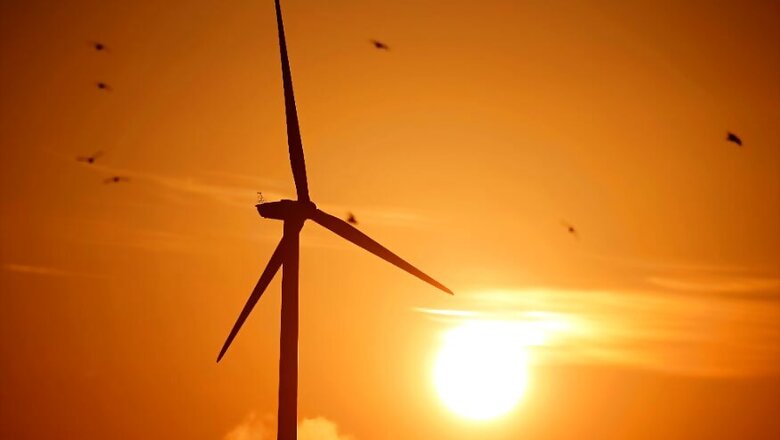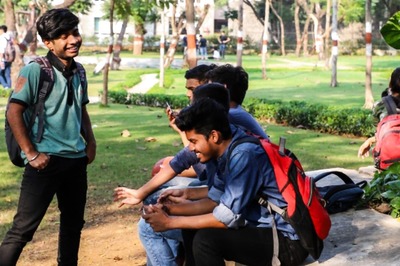
views
Gandhinagar: With production of renewable energy and associated infrastructure on the rise, the central government is going to fund mapping of hotspots where renewables might be a risk for migratory birds and their flyways in the future. The Bombay Natural History Society (BNHS), a non-government organisation, will prepare the first-of-its-kind dossier of these hotspots as part of a larger project which comprises of conservation of 79 sites (48 wetland sites and 31 land bird sites) across 17 states which are part of the Central Asian Flyway (CAF).
Flyways are areas used by groups of birds during their annual cycle, which includes breeding areas, stop-over areas and wintering areas. The CAF is one among nine crucial flyways for migratory birds and the national action plan on CAF conservation had identified 20 bird species for conservation in 2018.
The dossier, known as 'bird sensitivity mapping', will feed in as one of the tools used by the union ministry of environment, forest and climate change , its statutory bodies and expert panels while vetting projects for green clearances for renewable and other projects.
To begin with, mapping of areas in western region would be done. India has set itself a target of installing 175 GW of renewable energy by 2022. Renewable infrastructure such as transmission, lines and windmills pose a grave threat to the flyways and paths of migratory birds as well as local species of birds.
The project in its entirety, including the conservation plan for flyways, will be three years long and will be launched at the ongoing 13th United Nations convention on the conservation of migratory species of wild animals, being held in Gandhinagar, Gujarat.
The BNHS will receive an estimated Rs 4 crore funding for the broader project on implementation of the national action plan on flyways from the Compensatory Afforestation Fund or CAMPA fund. The CAMPA fund comprises of monies that are paid by project developers for razing forests and it is to be used by state governments and Centre for growing new forests elsewhere in lieu of the razed forests.
Under the Narendra Modi-led National Democratic Alliance (NDA) government, India has committed to build 175 gigawatts of renewable energy by 2022 and this was also presented to the world as one of India's key climate action goals at the Paris climate change conference of 2015.
Between March 2014 and October 2019, 47.86 GW of renewable energy capacity has been installed in the country and the 175GW renewables target will be met through 100 GW from solar energy, 60 GW from wind energy, 10 GW from biomass and 5 GW from small hydro. It is in this context that the critical, high-risk and low-risk areas would be identified with the help of BirdLife International, a global NGO that works on conservation of birds and their habitats.
“This report will be created keeping in mind our growing solar and wind energy infrastructure. It is great that we are raising our renewables production. However, if this infrastructure comes up in the wrong place, we will have problems with key migratory bird sites. So our idea is to give this dossier to the central government as to which areas are most vulnerable and or high-risk and which are low-risk for migratory birds. So, at the planning stage, the government and the project developer will be able to make an informed decision,” said Deepak Apte, Director, BNHS.
The Great Indian Bustard, which is the mascot of the on-going CMS event at Gandhinagar, is a key land bird species that is vulnerable due to the growing maze of power line corridors and gridlines. These birds have poor frontal vision and collide with power lines and poles, and get fatally wounded or electrocuted. Similarly, the majestic migratory flamingos that breed in the Rann of Kutch often get fatally electrocuted by power transmission lines.
Creation of specialised reports that are used to supplement the green clearance mechanism has been done before in the case of coal mining and for conservation of tiger corridors. The National Tiger Conservation Authority had identified 32 major tiger corridors and the expert panels of the environment ministry, and the wildlife board often uses the information to corridors to avoid or reject development projects. However, a report on go an no-go zones for coal mining, based on density and richness of forests, was never put to practical use for clearances.
“CAMPA funding is essentially project-based and a committee evaluates project seeking central CAMPA funding and we also evaluate state projects. The issue of viability of certain projects will come up once we have a report and we will have to see how we can balance the two,” said Chandra Kishore Mishra, Secretary, Union Environment Ministry.
Disclaimer: The writer was in Gandhinagar courtesy Government of India.




















Comments
0 comment